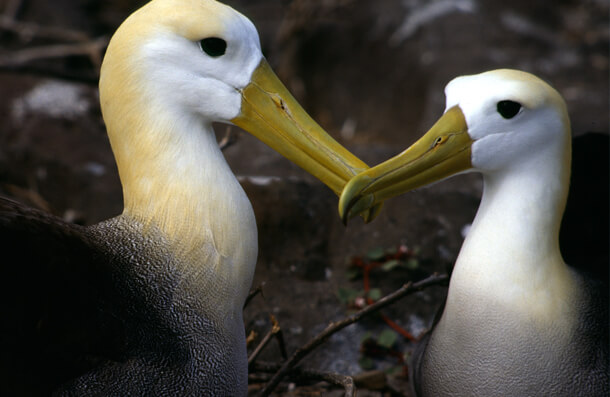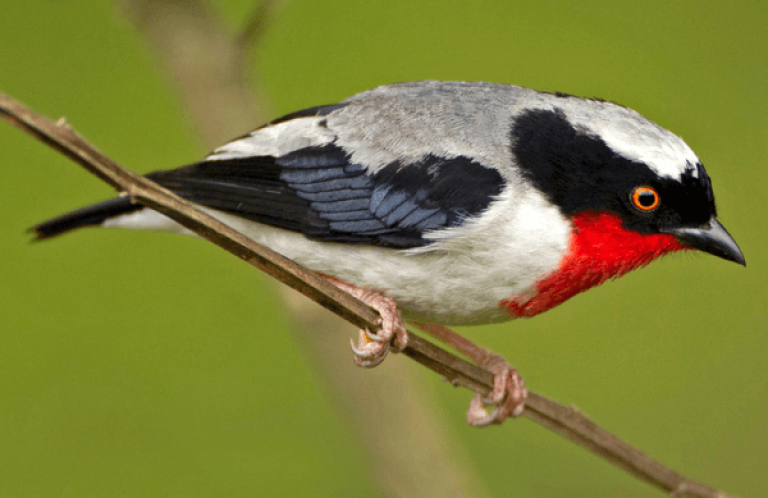New Fishing Technique Safer for Rare Birds and Fishermen
Fishing Innovation Presented at Meeting with Ecuador's Ministry of Environment
Robert Johns, American Bird Conservancy: 202-888-7472, Email click here
Gisella Andrea Rodríguez Suárez, Ministerio del Medio Ambiente, Ecuador: Email click here
 The Waved (Galápagos) Albatross, a critically endangered seabird, is often attracted by the bait and can become entangled in line and hooks. |
(Washington, D.C., January 8, 2015) A new technique designed to reduce the accidental and often fatal bycatch of seabirds in fisheries, including the critically endangered Waved (Galápagos) Albatross and the vulnerable Parkinson's Petrel, was presented at a recent meeting with the Undersecretary of Marine and Coastal Management of Ecuador's Ministry of Environment, Eliecer Cruz. At the meeting, Cruz endorsed the fishing innovation as a positive step toward mitigating this serious, global problem that results in the deaths of not only many birds, but also turtles, marine mammals, and other species.
The meeting, which focused specifically on the issue of seabird bycatch in the artisanal hake fishery in Ecuador, was held in the offices of the Ministry of the Environment in early December 2014 and was hosted by Cruz and Caroline Icaza Galarza, a specialist in marine and coastal management for the government of Ecuador. Also attending the meeting was Joanna Alfaro and Jeff Mangel, from the Peruvian conservation group ProDelphinus, and Hannah Nevins, who heads American Bird Conservancy's (ABC) Seabird Program.
Cruz commented in the meeting that he looks forward to the broad implementation of this innovation and that the large Ecuadorian fishing industry welcomes the new technology as well.
Icaza said the bycatch issue is particularly important to Ecuador since the country is one of the signatories to the Agreement on the Conservation of Albatrosses and Petrels (ACAP), an international agreement that requires signatories to find solutions to reduce seabird bycatch. Both ABC and ProDelphinus are members of the ACAP Seabird Bycatch Working Group.
According to Nevins, “Working to stop this bycatch by developing ways to minimize fishery and bird interactions will benefit the people and the birds.” Giovanny Suarez Espin, who has been working as a technical advisor to ABC on the bycatch issue, presented the novel method to reduce harm to birds and fishermen.
The fishing innovation, called the NISURI device, is named for the three people who developed it – Nigel, Suarez, and Ribera. The technique reduces by up to 90 percent the time required for “line setting,” the process of casting baited fishing lines in the water, during which the bait is visible and attracts birds. Line setting using this new technique is cut from 8 to 20 minutes to 1-2 minutes, substantially reducing the risk of accidentally snaring birds.
To employ the NISURI device, fishermen typically prepare up to 400 baited hooks and insert them into a six-foot-long NISURI tube, which holds the lines in order while protecting the bait from birds. The tube acts like a chute to deploy the lines without the possibility of hooks hanging up on a fisherman's hand or a bird's bill as the boat is underway.
“Line setting is the most dangerous time not only for fishermen but for birds as well, which seize an opportunity to take the bait at the surface of the water, not understanding the peril of being snagged on a hook and drowned. This technique reduces the exposure to this danger dramatically,” says Nigel Brothers of Humane Society International. Brothers has worked on the seabird bycatch issue for more than 30 years and has been working with Suarez to develop and implement NISURI.
Suarez is working with fishermen in the Ecuadorian Port of Santa Rosa, where he has convened three workshops leading to ten fishermen adopting the NISURI system last year. Suarez is planning another meeting of fishermen in 2015.
“The solution to the bycatch issue lies in developing ways to minimize fishery and bird interactions, and this technique does exactly that. In addition to the NISURI being safer for the fishermen, simple to use, and cost friendly, it also can be applied just about anywhere that artisanal fishing takes place,” said ABC's Nevins, who traveled to the port of Santa Rosa to see the NISURI in action.
Other attendees at the meeting were also supportive of the new technique. Dr. Ruben Aleman, from Machalilla National Park, suggested that this technology be used in other ports in Ecuador. Mariuxi García, the representative of the National Institute of Fisheries, said there was an opportunity to work together and reduce bycatch through a study of regulations in nearby Manta. The representative of the Ecuadorian Navy, Lieutenant Suarez, indicated they were interested in this work as they are responsible for the surveillance and protection of national maritime territory, including developing protocols for fishing activities.
Meeting participants have agreed to continue working together to promote this new method and expand its use in artisanal hake fisheries by supporting fishermen workshops in other ports in Ecuador.
American Bird Conservancy is the Western Hemisphere's bird conservation specialist—the only organization with a single and steadfast commitment to achieving conservation results for native birds and their habitats throughout the Americas. With a focus on efficiency and working in partnership, we take on the toughest problems facing birds today, innovating and building on sound science to halt extinctions, protect habitats, eliminate threats, and build capacity for bird conservation.


















































